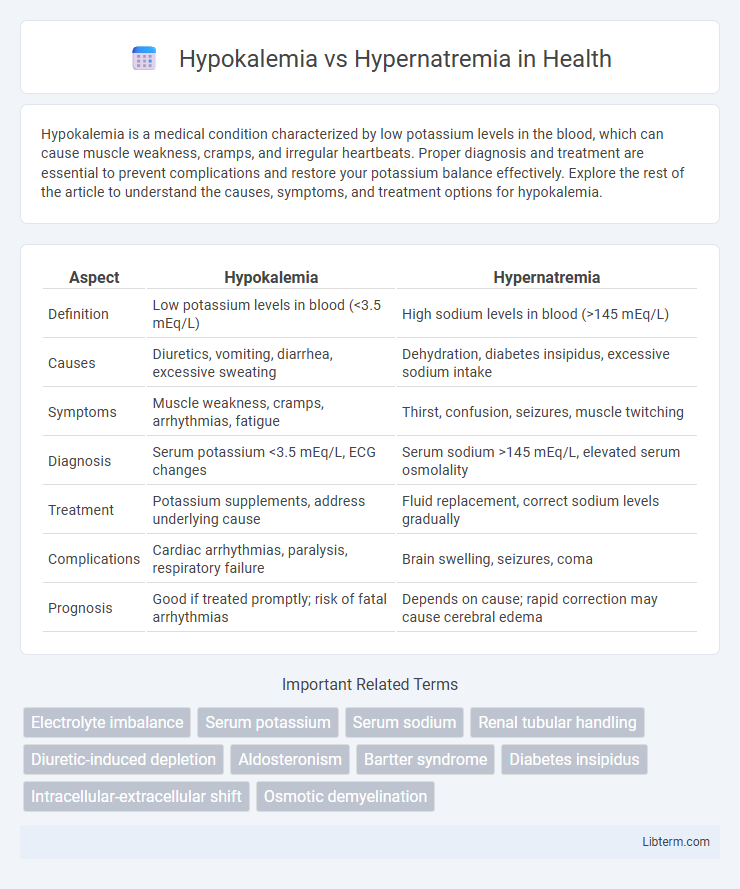Hypokalemia is a medical condition characterized by low potassium levels in the blood, which can cause muscle weakness, cramps, and irregular heartbeats. Proper diagnosis and treatment are essential to prevent complications and restore your potassium balance effectively. Explore the rest of the article to understand the causes, symptoms, and treatment options for hypokalemia.
Table of Comparison
| Aspect | Hypokalemia | Hypernatremia |
|---|---|---|
| Definition | Low potassium levels in blood (<3.5 mEq/L) | High sodium levels in blood (>145 mEq/L) |
| Causes | Diuretics, vomiting, diarrhea, excessive sweating | Dehydration, diabetes insipidus, excessive sodium intake |
| Symptoms | Muscle weakness, cramps, arrhythmias, fatigue | Thirst, confusion, seizures, muscle twitching |
| Diagnosis | Serum potassium <3.5 mEq/L, ECG changes | Serum sodium >145 mEq/L, elevated serum osmolality |
| Treatment | Potassium supplements, address underlying cause | Fluid replacement, correct sodium levels gradually |
| Complications | Cardiac arrhythmias, paralysis, respiratory failure | Brain swelling, seizures, coma |
| Prognosis | Good if treated promptly; risk of fatal arrhythmias | Depends on cause; rapid correction may cause cerebral edema |
Understanding Electrolyte Imbalances
Hypokalemia involves low potassium levels in the blood, often caused by excessive loss through urine, diarrhea, or inadequate intake, leading to muscle weakness, arrhythmias, and fatigue. Hypernatremia is characterized by elevated sodium levels, usually due to dehydration or impaired kidney function, resulting in neurological symptoms like confusion, seizures, or coma. Understanding electrolyte imbalances requires recognizing the critical roles potassium and sodium play in cellular function, fluid balance, and nerve signaling to effectively diagnose and manage these conditions.
Defining Hypokalemia and Hypernatremia
Hypokalemia is defined as a condition characterized by abnormally low potassium levels in the blood, typically below 3.5 mmol/L, which can lead to muscle weakness, arrhythmias, and metabolic disturbances. Hypernatremia refers to an elevated sodium concentration in the blood, usually above 145 mmol/L, often resulting from dehydration, impaired thirst mechanism, or excessive sodium intake, causing cellular dehydration and neurological symptoms. Both electrolyte imbalances require prompt diagnosis and management to prevent severe complications.
Causes of Hypokalemia
Hypokalemia, characterized by low serum potassium levels below 3.5 mEq/L, commonly arises from causes such as excessive gastrointestinal losses due to vomiting or diarrhea, diuretic use like loop or thiazide diuretics, and increased renal potassium wasting in conditions such as hyperaldosteronism. Other causes include inadequate dietary potassium intake and intracellular shifting of potassium seen in insulin administration or alkalosis. Understanding these etiologies is crucial for differentiating hypokalemia from hypernatremia, which involves elevated sodium levels often linked to water loss or sodium retention disorders.
Causes of Hypernatremia
Hypernatremia occurs primarily due to a deficit of free water in the body relative to sodium, often caused by insufficient water intake, excessive water loss through conditions like diabetes insipidus, or osmotic diuresis. Other common causes include gastrointestinal losses from vomiting or diarrhea, and the administration of hypertonic saline in medical settings. Identifying underlying causes such as renal dysfunction or impaired thirst mechanisms is essential for effective treatment and prevention of complications associated with hypernatremia.
Key Symptoms: Hypokalemia
Hypokalemia presents key symptoms such as muscle weakness, cramps, and fatigue due to low potassium levels disrupting cellular function. Patients may experience arrhythmias, including irregular heartbeats and palpitations, increasing the risk of cardiac complications. Severe hypokalemia can cause paralysis and respiratory distress, highlighting the critical need for timely diagnosis and potassium correction.
Key Symptoms: Hypernatremia
Hypernatremia primarily presents with neurological symptoms such as confusion, irritability, muscle twitching, and seizures due to cellular dehydration in the brain. Patients may also experience excessive thirst, dry mucous membranes, and decreased urine output as the body attempts to conserve water. Severe hypernatremia can lead to coma or death if not promptly treated.
Diagnostic Approaches and Laboratory Findings
Hypokalemia diagnosis involves measuring serum potassium levels below 3.5 mmol/L, alongside ECG changes like flattened T waves and U waves, while assessing urinary potassium excretion to determine renal versus extrarenal loss. Hypernatremia is identified by serum sodium levels above 145 mmol/L, with laboratory findings revealing elevated osmolality and potential dehydration markers; urine sodium concentration helps differentiate between renal salt loss and water deficit causes. Both conditions require thorough evaluation of electrolyte panels, arterial blood gases, and clinical context to guide targeted management strategies.
Treatment Strategies for Hypokalemia
Treatment strategies for hypokalemia involve potassium supplementation through oral or intravenous routes, depending on severity and symptoms. Monitoring cardiac function and electrolyte levels is crucial to avoid complications such as arrhythmias. Identifying and managing underlying causes, including diuretic use or gastrointestinal losses, enhances treatment efficacy and prevents recurrence.
Treatment Strategies for Hypernatremia
Treatment strategies for hypernatremia primarily involve gradual correction of serum sodium levels to avoid cerebral edema, typically achieved through administration of hypotonic fluids such as 5% dextrose in water or half-normal saline. Careful monitoring of electrolyte balance, urine output, and underlying causes like dehydration or diabetes insipidus is essential for effective management. In severe cases, addressing the underlying pathophysiology with vasopressin analogs or adjusting diuretics may be necessary to restore sodium homeostasis safely.
Prevention and Management of Electrolyte Disorders
Preventing hypokalemia involves maintaining adequate dietary potassium intake through foods like bananas, oranges, and leafy greens, while managing underlying causes such as diuretic use or gastrointestinal losses. Hypernatremia prevention centers on ensuring proper hydration and monitoring sodium intake, especially in vulnerable populations like the elderly or those with impaired thirst mechanisms. Effective management of these electrolyte disorders requires regular serum electrolyte monitoring, prompt correction of imbalances using appropriate intravenous fluids or supplements, and addressing any underlying conditions contributing to the disturbances.
Hypokalemia Infographic

 libterm.com
libterm.com